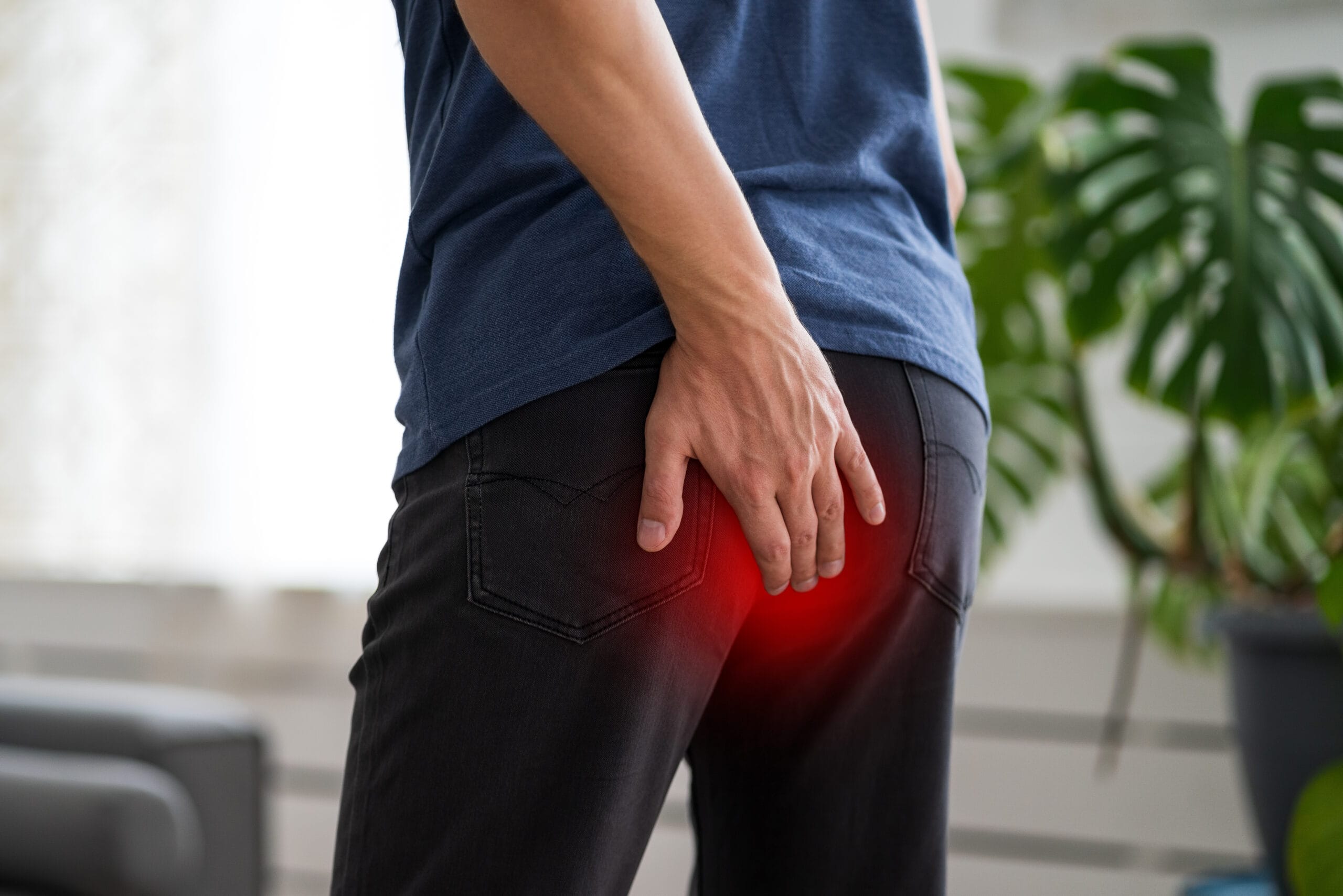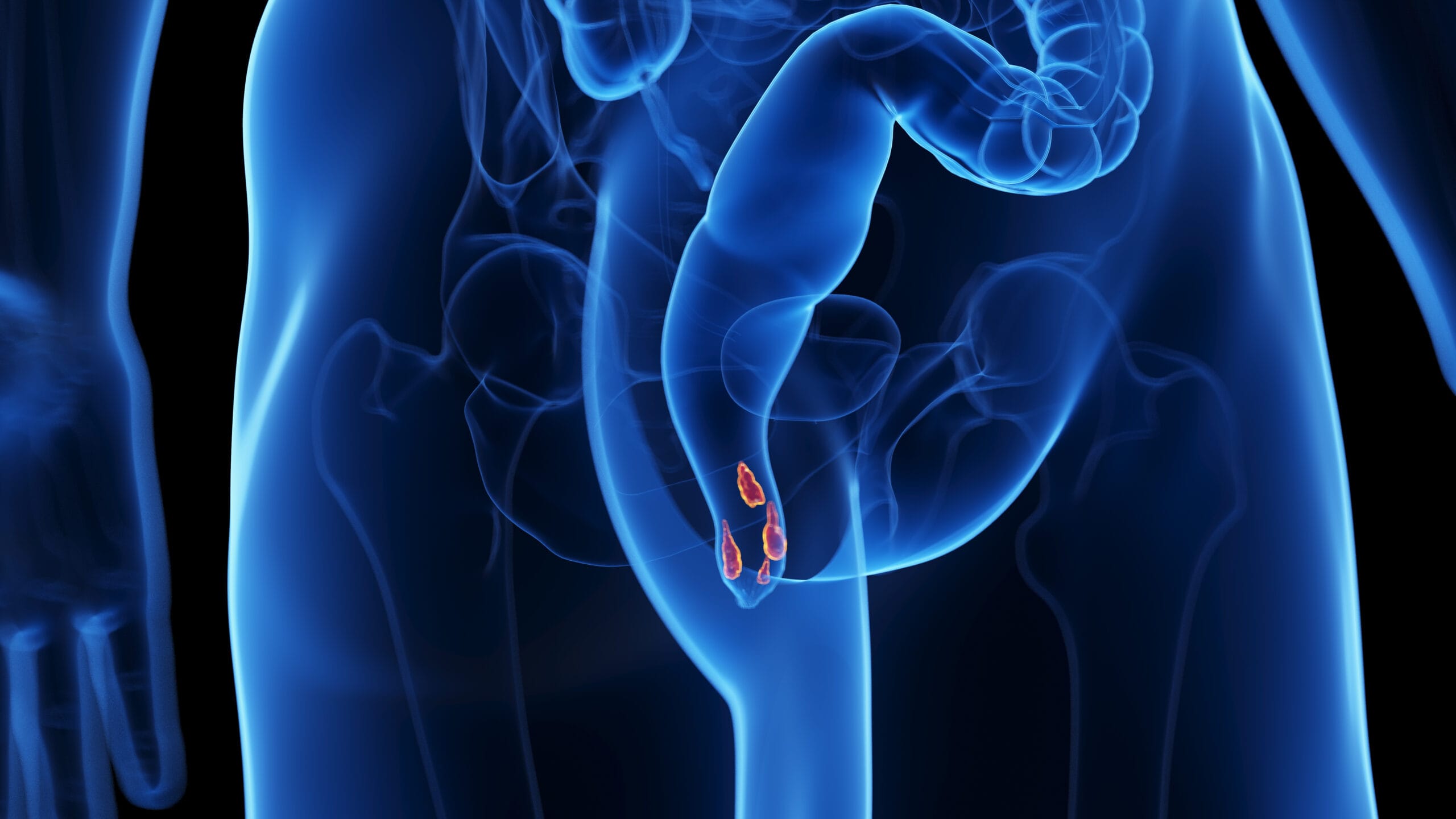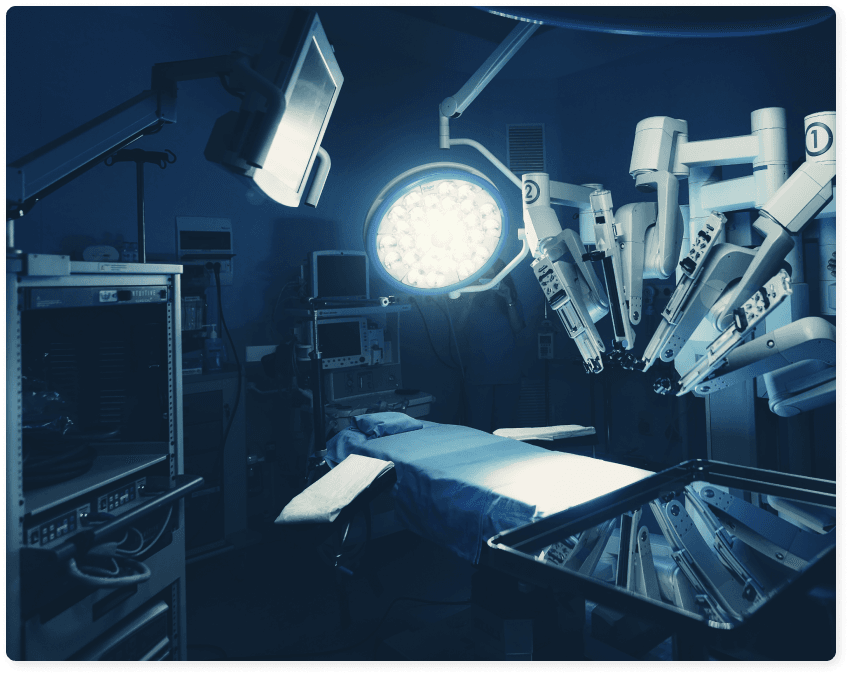Hemorrhoids
Hemorrhoids is a common disorder that can significantly affect the quality of daily life.
Their occurrence becoming ever more frequent due to the intense stress and poor nutrition of the western lifestyle, hemorrhoids can be fully treated with minimally invasive techniques, with immediate results and without any inconvenience to the patient.
Because of the area where the problem appears, patients usually avoid talking about their condition and seek medical help only when it ends up affecting their daily lives.
A correct diagnosis along with a differentiation from other potential disorders of the area, such as fissures, rectal prolapse and anal abscesses, must be carried out by a surgeon with experience in the pathology of the area.

What are Hemorrhoids?
Hemorrhoids are a normal anatomical feature of the anal area. They are essentially blood vessels, small veins and arteries that carry blood to the anus.
Hemorrhoids form a cluster of blood vessels called the rectal venous plexus (or hemorrhoidal plexus). Together with the superficial mucosa and submucosa, they form a protective tissue in the area where the anal sphincter is located.

During defecation, as the sphincter relaxes, the mesh empties of blood and is refilled after the end of the process. Thus hemorrhoids, to some extent, help the anal sphincter to close the gap of the anus and contribute to fecal restraint.
The problem starts when the hemorrhoids swell and the tissues that hold them in place relax.
Why choose Dr. Konstantinidis?
Dr. K. M. Konstantinidis and his team possess vast experience in the field of laparoscopic and robotic surgery.
Dr. Konstantinidis is the pioneer of Robotic Surgery in Greece and one of the leading figures internationally in the field, having performed the largest series of General Surgery operations in Europe with the innovative Da Vinci® robotic system, including inguinal hernia surgeries.
What are the symptoms of Hemorrhoids?
Any discomfort in the anal area should be immediately assessed by a specialist.
The signs and symptoms of hemorrhoids include:
Pain in the anal ring area
Bleeding
Mucus secretion
Local irritation
Itching
Asymptomatic or painful swelling
Feeling of incomplete defecation
How are hemorrhoids categorized?
Hemorrhoids are categorized into:
- Internal hemorrhoids. In their initial stage, hemorrhoids are not immediately visible, but the doctor can observe them with a special instrument, the proctoscope. Internal hemorrhoids usually do not cause pain but are manifested with bleeding.
- External hemorrhoids. When the hemorrhoids are not treated, they swell even more and protrude out of the anus. Then the patient can feel them and most of the time rearrange them into the anus. Sometimes, however, the hemorrhoids cannot be rearranged, causing anal pain, burning, itching, and a feeling of incomplete defecation. These symptoms cause the patient to avoid defecation resulting in constipation.
What are the levels of severity for Hemorrhoids?
Depending on the severity of the symptoms, hemorrhoids are categorized into:
- First degree: when the hemorrhoids protrude slightly or not at all out of the anus and may bleed
- Second degree: when the hemorrhoids protrude only during defecation and return automatically into the anus, after it is completed
- Third degree: when hemorrhoids bleed, they can be rearranged only with the intervention of the patient
- Fourth degree: when hemorrhoids remain permanently outside the anus (prolapsed) causing pain, severe irritation, and bleeding, and cannot be rearranged
What causes Hemorrhoids?
There are many causes that contribute to the formation and occurrence of hemorrhoids, with constipation being a primary one.
Constipation is often due to hereditary reasons, as well as poor diet, low in fiber, as is the case in Greece and all western societies in recent decades.
Other causes that contribute to hemorrhoids are:
- Pregnancy (in most women the problem disappears after giving birth)
- Sitting on the toilet for a long time
- Age (a natural cause for tissue relaxation)
- Chronic severe cough because it increases intra-abdominal pressure
- Hereditary predisposition
How are Hemorrhoids diagnosed?
The diagnosis starts with taking the patient’s history and a physical examining of the area, by a specialized surgeon.
Additionally, a finger examination, orthosigmoidoscopy or proctoscopy may be performed to further obtain information about the disorder or other potential conditions relating to the problem.

How are Hemorrhoids treated?
Treatment of early stage hemorrhoids can be conservative and may include the following approaches:
- Treatment for constipation. This presupposes changes in the patient’s daily life starting from the increase of fiber intake in the diet, as well as the daily consumption of water. The American College of Colon and Rectal Surgeons advises consuming 6-8 glasses of water and at least 30 grams of fiber daily. Also, remaining seated on the toilet should be avoided and defecation should be as short as possible.
- Sclerotherapy with sclerosants. It concerns the infusion of substances that cause fibrosis and shrinkage of hemorrhoidal meshes. This treatment does not always have a good outcome and can be painful.
- Use of rubber bands. This is a particularly effective method for small 1st-2nd degree hemorrhoids. Essentially, the elastic bands strangle the hemorrhoids, which then become ischemic and “wither”. The placement of the bands does not require general anesthesia.
- Use of topical ointments in the anal area. Topical ointments help, but only temporarily, while their overuse can lead to atrophy of the skin of the anus (due to the cortisone that these ointments often contain) but also to dangerous forms of anal dermatitis, which can be more torturous and difficult to cure than the hemorrhoids themselves.
The conservative methods of treatment should last up to two weeks. In some cases, such as hemorrhoidal thrombosis, we proceed to surgery right from the start.
When hemorrhoids persist and conservative treatment has no effect, when they are very swollen and cannot be rearranged and especially when they are constantly bleeding, then a surgical treatment is the only choice.
There are several methods of surgical treatment for hemorrhoids, such as:
- Hemorrhoid resection with the Milligan Morgan method. It involves the surgical resection of hemorrhoidal nodules. In this method, special care must be given to maintain cutaneous mucosal flaps between the excision points, to avoid narrowing of the anus, which is particularly painful.
- Hemorrhoid resection with the Logo method. With the use of a circular stapler, the hemorrhoidal vascular cushions and the loose tissue that surrounds them are removed. This technique has very good outcomes, in the hands of an experienced surgeon. Postoperative pain is minimal.
- Sphincterotomy, dilatation of the anal ring. This method is applied in cases where of a hypertonic sphincter, such as in the case of a thrombosed external hemorrhoid.
- Ultrasound assisted Hemorrhoid Ligation (THD and HAL_RAR Methods). Hemorrhoids restoration with the help of ultrasound.
- Laser Hemorrhoidoplasty (LHP and Help Techniques). Painless and bloodless treatments using a special therapeutic laser.
What is Hemorrhoidectomy Using Special Diathermy?
In some cases, diathermy techniques using lasers, infrared radiation or heat are used to treat hemorrhoids.
The purpose of these techniques is to cause small, bleeding internal hemorrhoids to harden and shrink.
Treatment of hemorrhoids using ultrasound - Doppler (THD, HAL-RAR, ANGIODIN)
What is the THD Method?
The THD (THD Doppler) method involves finding the vessels that supply the hemorrhoids, with a special ultrasound built into the proctoscope, and ligating them.
So, the hemorrhoids go ischemic and wither! At the same time, with a special suture, the entire mucosa of the anus is rearranged inwards, essentially reconstructing the anatomy of the area.
This technique offers excellent and permanent therapeutic results, with particularly high levels of patient satisfaction after surgery.
The operation lasts about half an hour on average. The pain after surgery is minimal or non-existent.
The patient can return home the same day and to his/her daily activities the next day.
No special pre- or postoperative care or medication is required. Especially for hemorrhoids that bleed the results are immediate.
The THD method is suitable for all four degrees of hemorrhoids that cause problems.
What is the HAL – RAR Method?
The HAL – RAR method involves the use of ultrasound (Doppler). It is suitable for the treatment of low to moderate hemorrhoids and is extremely effective in treating the symptoms.
Hemorrhoid ligation with this method helps to reduce the arterial blood supply, causing the hemorrhoids to shrink to their normal size.
The RAR method is used to treat protruding hemorrhoids that appear in more advanced stages of the disease.
RAR involves carrying out one or more mucopexies of the prolonged mucosa after the ligation of the hemorrhagic arteries.
Laser hemorrhoid treatment (HeLP technique, LHP hemorrhoid)
What is the LHP technique?
LHP® (Laser HemorrhoidoPlasty) is an innovative treatment for advanced hemorrhoids (2nd – 4th degree).
It is a minimally invasive technique which is performed with a special surgical laser and offers excellent therapeutic results with absolute safety.
It is painless, bloodless and is accompanied by immediate recovery with little or no postoperative pain.
What is the HeLP method?
The HeLP ™ method (Hemorrhoid Laser Procedure) is a completely painless endoscopic laser treatment, which is indicated for the treatment of 2nd and 3rd degree hemorrhoids.
This treatment is performed under the guidance of ultrasound and using a laser, which has a hemostatic effect and cuts the swollen hemorrhoids off from the blood supply.